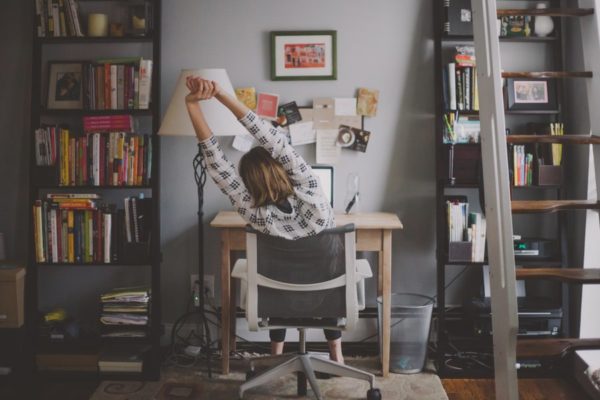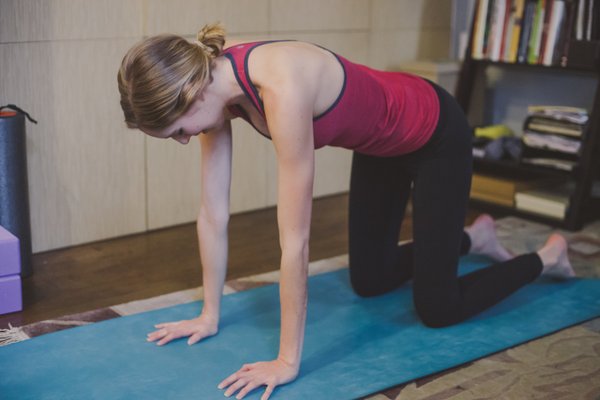
I’ve been pretty injury prone for most of my life, including a rather impressive month in high school when I tore ligaments in both ankles and then broke three toes in my sleep (thanks to a very realistic dream about soccer). Still, I thought I would at least be the proud owner of a midlife crisis convertible before my back decided to go out on me.
But alas, that fateful day came a few years ago as I was leaving to catch a plane to San Sebastian. If it hadn’t been for the non-refundable ticket, I would have likely stayed on the floor for hours. But instead I muscled my pants on, and gingerly poured myself into a taxi. On the recommendation of my chiropractor, whom I called from the car, I pounded Alieve like candy and spent the entire night flight pacing back and forth in the aisles, which the flight attendants weren’t thrilled about. And on the recommendation of my mother, I drank a lot of red wine upon arrival, and kept it flowing for the next week of my solo travels.
As silly as they seem, these tactics saved me. But I instinctively knew that painkillers in pill and bottle form would only get me so far. After another year of chronic pain and occasional spread eagle paralysis on the floor, I realized that there was clearly a root cause not being addressed.
“Pain isn’t the problem. It’s just a message that you have a problem,” said Jesse Cannone, the founder of The Healthy Back Institute, when I interviewed him last fall for my Wellness Wednesday series.
A lot of people blame what they were doing at the time of a back crisis—lifting a skillet, bending over a plate of crab cakes, putting on pants, to name a few of my fateful activities. But usually these on-going issues are due to a deeper problem that is always lurking, even after the pain has abated.
“Our spines were just not built to last,” my mom told me when I first threw out my back. She blames my grandfather, who was 80 percent limbs, for passing down the genetic makeup of our “rickety framework.” Perhaps our lank has given us a handicap from birth, making us more likely to break during low intensity sports, like sleeping. But as much as I love blaming my family members for my problems, it’s much more likely that my back issues are a result of how I’ve been using my body.
One of the biggest causes of back pain is muscle imbalance. There are many things in modern life that can cause our alignment to get out of whack. High heels force your center of balance to shift forward, straining your lower back and causing your calf muscles to shorten, leaving you misaligned when you’re walking around barefoot. Chopping vegetables at the counter for hours on end creates imbalance by favoring one side of your body over the other. But the biggest overall culprit of back, strength, and alignment issues is sitting.
When you sit all day, gravity puts enormous pressure on your spine, no matter how rickety it was to begin with. It also shortens the muscles on the fronts of your hips and the backs of your legs. When we get up, our body continues to subtly hold that unnatural chair-like shape.
Unfortunately, even the most intense Barry’s Boot Camp class can’t begin to undo the damage of remaining in one stagnant position for most of the day. “Just as supplements shouldn’t be the bulk of your diet, exercise should not be the bulk of your movement profile,” says Katie Bowman, author of Move Your DNA and one of the many leaders of the anti-sitting mafia.
Stress is also a huge factor in back pain. When you feel anxiety, your breathing becomes shallow. Whether conscious or not, these small psychological shifts limit the amount of blood that flows to your extremities. The average American has about fifty brief stress spikes a day, which makes movement even more important to get blood flowing again.
Perhaps the fact that my mother, grandfather and I are all neurotic writers, hunched over desks for most of the day, might have more to do with our back issues than the length of our limbs.
Regardless, last month I finally decided to check myself into movement rehab. Read on to find out how I fared!
Xo
Phoebe

Instead of focusing on throwing in some random squat thrusts on your way to the kitchen, the easiest way to improve your movement profile is just to not sit as much in the first place.
Since I learned that the brain starts registering your body’s position as the norm after an hour, I tried not to be on my butt for more than 45 minutes at a time. To do so, I used a kitchen timer on my desk to keep me on task.
As you can imagine, a loud startling ring every hour got really old, really quickly. But I couldn’t find another way of timing myself that didn’t make me a basket case. So after a few days, I started using another passive technique that harnessed the power of one of my other wellness experiments: hydration.
As it turns out, drinking a boat load of water throughout the day pretty much necessitates getting out of your chair once an hour to either a) refill your glass or b) pee. Focusing on keeping my water bottle full had an awesome halo effect on my movement habits, and was a whole lot more enjoyable than watching the clock or literally jumping out of my chair at the sound of a loud alarm.
That said, movement quickly became an unhealthy form of procrastination that got in the way of my work.
Unfortunately, writing a book about wellness might be the unhealthiest thing I could ever do. I won’t unpack all the emotional reasons behind that statement. Let’s just say that my average daily stress spikes have increased significantly, and I now understand why so many of our world’s great wordsmiths were also terminally depressed alcoholics. But aside from the self-doubt and isolation, the physical ramifications are obvious. When I’m on my best possible writing tear, I will lose hours concave over my screen. And on those precious productive occasions, the last thing I need is an alarm breaking my train of thought every 45 minutes.
So as a second strategy, I tried to make my workplace more ergonomically friendly.
I got a cheap standing desk that sat in my front hallway, unopened for a few months. During this experiment I finally got around to unwrapping it, and worthy of the price, it was a total pain in the ass to set up. I’m embarrassed to say that I procrastinated this feat for most of the month and still haven’t been able to bring myself to use it. Next week, I hope?
In the meantime, I’ve been gathering some anecdotal information from my brain trust of standing desk users – all of whom live in San Francisco and work in tech, and therefore have been given the gift of ergonomics for free, along with limitless green juice and mid-day office yoga. (Ugh.)
Here’s what my anonymous sources had to say:
• It’s great to start the day with a standing desk. It helps wake me up a bit by forcing me to be more active during times when my standard is sleepiness, like in the morning or after lunch.
• They take some discipline. If my desk is down, I’m lazy and won’t raise it up. I’ve gone weeks without using the standing desk. The key is to never lower the desk. I tend to have a lot of meetings throughout the day and I get my sitting done in those.
• Green juice and granola bars taste extra good when at your standing desk.
(Again…ugh.)
• Make sure to raise your monitor so it’s at eye level. If you have to look down, you will continue to slouch, even while standing.
• In general I think I’m more productive. I’ve noticed I procrastinate less when I stand. It focuses me a bit more. There’s a very dangerous progression from sitting in your desk chair, upright and active, to slouching in your seat, to sprawling out on the couch. And with each move I consume more espn.com articles.
(The female equivalent is the Daily Mail, or Taylor Swift’s Instagram.)
• I can’t do long periods of productive work at the standing desk. It’s better for context switching between various tasks.
Per their recommendations, I’ve set up a second desk area on a console in my studio apartment that I plan to leave up. I’ll have to get back to you on whether or not I’m able to context switch and actually use it.

I don’t think that moving more could have fixed my problems alone. After seeing an integrated body worker for a few weeks and getting my alignment back to normal, it was clear that one of my root causes was a crisis of weakness.
If your sacrum is off, it’s the first thing that needs to be fixed. But if you don’t have a strong core, there’s nothing to prevent it from shifting right back out of place. Your pelvic floor is at the base of your spine and will support it in a way that a lot of other stuff won’t.
Even once my pelvis was realigned, the surrounding muscles were so unstable that even the smallest movements could throw it back into turmoil. The shooting pains I felt during during times of crisis were a result of my body feeling super insecure about its ability to stabilize itself—so it used scare tactics to try to get me to move as little as possible.
To get my strength back, I started doing the pelvic floor exercises I described here. Every morning I woke up and did supported bridge pose for 5 minutes. While my pelvis was chilling on the yoga block and easing into proper alignment for the day, I did these kegel-like exercises.
The second most helpful thing for my strength crisis was pilates. While yoga had caused me more pain as I tried to bend myself into positions that were stressful on my rickety spine, the slow and targeted movements in pilates helped me isolate my problem areas and rehabilitate them.
My most recent crisis was back in November, when I ended up laid out after shooting these crab cakes. Once I finally got up, instead of the chiropractor, I went directly to my pilates teacher. I left her studio with a much better range of motion, for half the cost of a doctor, with the tools to continue improving.
After a few months of pilates and pelvic floor exercises, I could get away more easily with some of my bad writing habits without feeling that dull worrying pain that meant I was on the brink of another disaster.
If you’re looking to heal back pain of your own, I would consider experimenting with hydration and an anti-inflammatory diet, as dehydration and bad diet are two lifestyle areas that also contribute to these issues. As for stress, you’ll have to wait for me to tackle that one myself.
The Wellness Project is now a book! It’s part memoir, part health primer, with 20 inflammation fighting recipes for clearer skin, better digestion, and a thriving thyroid. (Because who doesn’t wake up in the morning wanting a thriving thyroid?!). You can read more and preorder here. To read up on past experiments and get more tips from the trenches, click here.

as a long time Pilates devotee I can speak to the benefits of it on your body & every day well being….if, you have the right instructor. Since finding mine, I walk differently, have found the ease of finding my abs without “pulling in my stomach”, & the strength of my core with proper body & head alignment. It is so simple & inexpensive; no fancy equipment, just the simplest things make a huge difference. But… you have to take responsibility for your own body & do the work-it’s worth it!
thanks for sharing karin! if there’s anything i’ve discovered from my project, it’s that with most of this stuff, you have to be willing to put in the work. eventually though changes stick. but it takes effort to get out of the weeds. xo
I tried Feldenkrais for my back and they changed my posture forever, but they can’t make you strong if your support is weak. You’re so right, it’s something you have to do for yourself.
will check it out!
Thanks for sharing! I’ve been inspired to start a mini wellness project for myself.. And first thing on my list is my back pain! <3
That’s amazing to hear Amy! Let me know if I can do anything to support you on your mission xoxo
Yoga postures as a means to straighten and strengthen the back aren’t that hard to do especially if you’re under the guidance of a good yoga instructor or personal trainer. One should also consider foundation training.